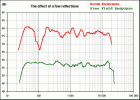Here's a little more about this with how speakers work in regular listening rooms:
"Yes, SBIR (Speaker Boundary Interference Response) is a huge problem in almost all non-equalization systems. Peaks and valleys in the middle register often have a catastrophic impact on sound quality. The only passive solution that is normally practical is a large baffle or recess in the wall (a very flat speaker also works well against a wall). Otherwise, a proper distance to the speaker wall (around 1 m or so) is required to place the SBIR valley so low in frequency that it can be balanced by various modal influences. However, the floor reflection remains, which also adds to it in this respect if you do not place the base element close to the floor.
I just want to imply that I relatively recently developed equalization settings for a couple of speaker models that can be mounted in e.g. a roof corner. Without equalization, it will of course be almost unheard of, while in this context it sounds remarkably good with equalization. This illustrates why equalization is often not the last resort but the only resort"

